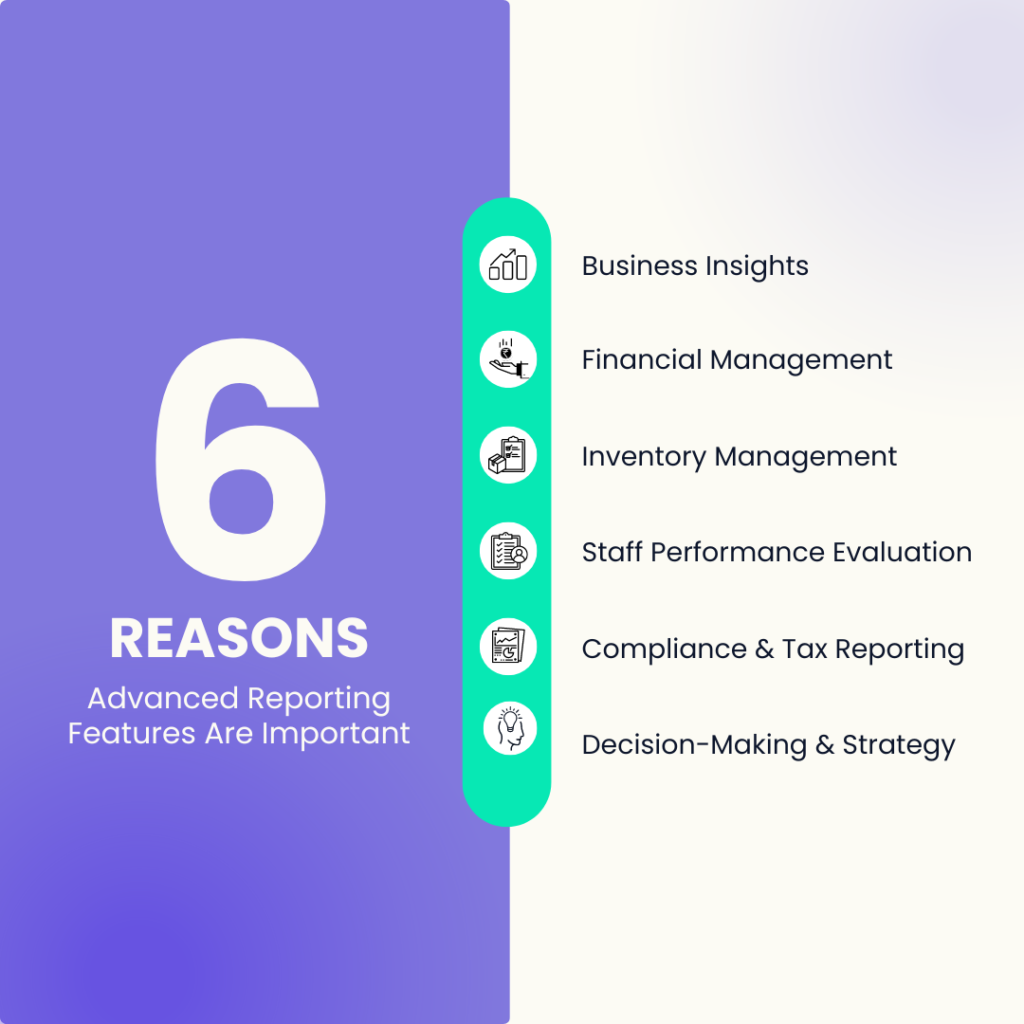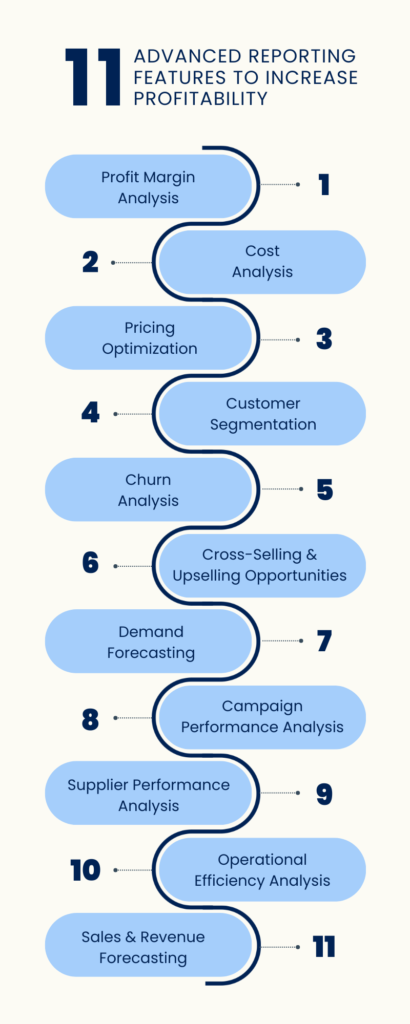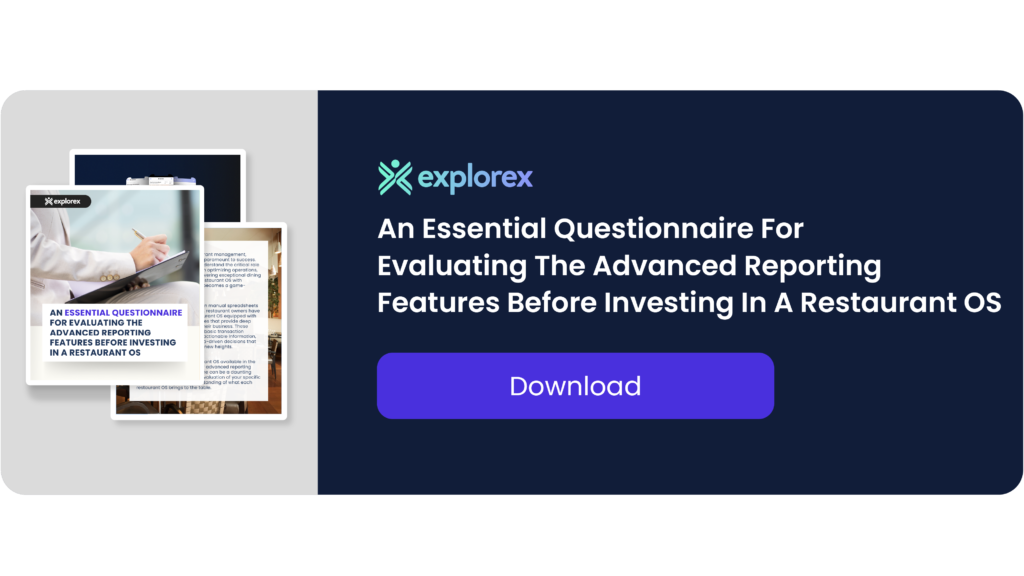In the fast-paced and competitive world of the restaurant industry, having access to accurate and insightful data is essential for making informed business decisions. This is where the power of advanced reporting in a restaurant OS comes into play. Gone are the days of relying solely on manual record-keeping and guesswork. With advanced reporting capabilities, restaurant owners and managers can unlock valuable insights about their operations, customer preferences, sales trends, and more.
In this article, we will take a look at a few types of reports and discuss how they can help optimize processes, drive profitability, and deliver exceptional dining experiences. Get ready to discover how harnessing the power of advanced reporting can revolutionize your restaurant business.
To start, you first need to know what advanced reporting features you can expect in a well-built ecosystem. The array of features can include:
- Overall report: A comprehensive report that provides an overview of various metrics and performance indicators across different areas of your business.
- Sales summary report: Summarizes sales data, including total sales, revenue, average order value, and other relevant sales metrics.
- Settlement report: Provides information about financial settlements, such as payment methods, transaction details, and settlement amounts.
- Special insights: An advanced reporting feature that offers unique and valuable insights into specific aspects of your business to make insightful decisions.
- ATS vs. TAT: Compares average time to serve (ATS) and turnaround time (TAT) to analyze operational efficiency and service speed.
- Popularity analysis | Overall: Analyzes the overall popularity of products, services, or offerings to identify the most popular ones.
- Popularity analysis | Tag wise: Analyzes the popularity of products or services based on specific tags or categories.
- Item-wise sales | Overall: Provides detailed sales data for each item or product in your inventory, giving insights into their overall performance.
- Item-wise sales | Tag-wise: Analyzes sales data for individual items or products based on specific tags or categories.
- Area-wise report: Provides insights into sales or performance data based on geographical areas or regions.
- Discount report: Analyzes discounts applied to sales transactions, including the types of discounts, their amounts, and their impact on revenue.
- NC report: Tracks and reports non-compliance incidents or issues, highlighting areas where improvement is needed.
- Write-off report: Provides information about inventory write-offs, including reasons, quantities, and values of items written off.
- Table-wise report: Analyzes data related to tables in a restaurant or hospitality setting, including table occupancy, turnover, and revenue generated per table.
- Waiter-wise report: Provides insights into individual servers’ performance, including the number of tables served, orders taken, and total sales.
- Reprint bill report: Tracks instances where bills or invoices have been reprinted, providing a record for auditing purposes.
- Steward attendance: Monitors and reports the attendance of stewards or waitstaff, ensuring accurate tracking of working hours and shifts.
- Online delivery dashboard: Offers a dashboard designed to monitor and analyze online delivery operations, including order volumes, delivery times, and customer satisfaction.
- Cancellation report: Tracks and analyzes order cancellations, including reasons for cancellations, frequency, and impact on revenue.
- Inventory dashboard: Provides an overview of inventory levels, stock movement, and other inventory-related metrics to aid in inventory management and control.
- Service charge removal report: Tracks instances where service charges have been removed from bills, ensuring transparency and accountability.
- Payment reports: Payment reports on the total number of expenditures carried out with customizable dates.
- Tip report: Analyzes tip amounts received by staff, providing insights into customer tipping behavior and total gratuities earned.
- EDC Machine rent: Tracks and reports the rental fees associated with electronic data capture (EDC) machines or card payment terminals.
- Category-wise report: Analyzes sales or performance data based on different categories or groups, such as product categories or service types.
And why are these reports important for a restaurant?

1. Business Insights:
- Advanced reporting provides valuable insights into your restaurant’s performance. It offers detailed sales, revenue, and profitability data, allowing you to analyze trends, identify patterns, and make informed business decisions.
- With access to comprehensive reports, you can understand which menu items are popular, determine peak hours, track sales by category, and evaluate the effectiveness of promotional campaigns.
2. Financial Management:
- Accurate financial management is vital for the success of any restaurant. Advanced reporting enables you to track expenses, monitor costs, and calculate profit margins.
- By analyzing financial reports, you can identify areas where costs can be optimized, ensure profitable pricing, and manage inventory effectively.
- It helps you maintain control over your restaurant’s financial health and make informed decisions to improve profitability.
3. Inventory Management:
- Efficient inventory management controls costs and prevents stockouts or excess inventory.
- Advanced reporting in a restaurant POS system provides real-time insights into inventory levels, allowing you to track ingredient usage, monitor stock movement, and generate purchase orders when needed.
- It helps you optimize inventory levels, reduce waste, and avoid shortages, ensuring a smooth flow of operations.
4. Staff Performance Evaluation:
- Advanced reporting allows you to assess the performance of your staff members. You can track individual sales, analyze average order values, and measure upselling or cross-selling success.
- These insights help you identify top-performing employees, identify training needs, and incentivize high-performing staff.
- You can optimize your team’s efficiency and enhance customer service by leveraging performance data.
5. Compliance and Tax Reporting:
- Restaurants need to comply with various regulatory requirements and tax obligations. Advanced reporting simplifies compliance by generating accurate reports for tax purposes.
- It can automatically calculate and track taxes, provide detailed sales reports, and generate necessary documents like sales tax reports or employee tip reports. This streamlines your tax reporting process and ensures compliance with applicable laws.
6. Decision-Making and Strategy:
- The availability of comprehensive data through advanced reporting empowers restaurant owners and managers to make data-driven decisions.
- Whether it’s menu engineering, pricing adjustments, expansion plans, or marketing strategies, advanced reporting provides the insights needed to evaluate performance, identify opportunities, and develop informed strategies to drive growth and profitability.
What more can the advanced reporting feature offer to increase profitability?

Advanced reporting features can offer several capabilities to increase profitability. Such as:
1. Profit Margin Analysis:
An advanced reporting feature can provide insights into profit margins at various levels, such as overall, product-wise, or customer-wise. This analysis helps identify high-profit and low-profit areas, enabling you to focus on products or customer segments that yield higher margins.
2. Cost Analysis:
It can help analyze costs associated with different business processes, such as production, inventory management, or marketing. You can take corrective actions to reduce expenses and improve profitability by identifying areas of high costs or cost inefficiencies.
3. Pricing Optimization:
The pricing optimization feature helps analyse customer buying patterns, competitor pricing, and market trends to adjust your pricing strategies inturn maximizing profitability while remaining competitive.
4. Customer Segmentation:
An Advanced reporting feature can segment customers based on various criteria, such as purchasing behavior, demographics, or profitability. This allows you to prioritize high-value customers, tailor marketing efforts, and provide personalized experiences that drive customer loyalty and higher sales.
5. Churn Analysis:
By using this feature to analyze customer churn or attrition rates, you can identify why customers leave your business. This information helps you proactively improve customer retention, reduce churn, and retain valuable revenue.
6. Cross-Selling and Upselling Opportunities:
It can identify cross-selling and upselling opportunities by analyzing customer purchase history and preferences. You can increase the average order value and drive incremental revenue by recommending relevant products or services to customers.
7. Demand Forecasting:
Advanced reporting can utilize historical data, market trends, and predictive analytics to forecast future demand accurately. Accurate demand forecasting helps optimize inventory levels, minimize stockouts, reduce holding costs, and avoid overstocking, ultimately improving profitability.
8. Campaign Performance Analysis:
It can evaluate the performance of marketing campaigns by tracking key metrics such as conversion rates, customer acquisition costs, and return on investment (ROI). This analysis helps allocate resources effectively, focus on the most successful campaigns, and eliminate underperforming ones, leading to higher profitability.
9. Supplier Performance Analysis:
This feature can assess supplier performance by analyzing delivery times, quality, and pricing metrics. By identifying reliable and cost-effective suppliers, you can negotiate better terms, reduce costs, and enhance profitability.
10. Operational Efficiency Analysis:
They can uncover inefficiencies in operational processes, such as production, logistics, or customer service. Streamlining operations, eliminating bottlenecks, and reducing costs can improve overall efficiency and increase profitability.
11. Sales and Revenue Forecasting:
Advanced reporting can provide accurate sales and revenue forecasts based on historical data, market trends, and predictive modeling. These forecasts help you set realistic targets, allocate resources effectively, and make informed business decisions to achieve higher profitability.
In a world where profitability reigns supreme, advanced reporting features shine as unsung heroes. They empower businesses to unveil hidden treasures buried within data, guiding them on the path to increased profitability. From profit margin analysis to customer segmentation, these reporting tools offer the keys to unlocking success.
But why settle for just bits and pieces of this lucrative puzzle? If you’re yearning for a seamless ecosystem that brings together all these features under one digital roof, it’s time to embark on an extraordinary journey with Explorex. Take the leap, embrace the extraordinary, and unlock the full potential of your business.
Don’t miss out on the opportunity to supercharge your profitability.
Get in touch with Explorex today at sales@explorex.co and start embarking on a profitable journey.





